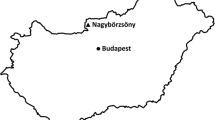Abstract
Six standard polytypes of micas exist that have c-periodicities between 1 and 6 layers; these can be subdivided into groups A and B according to whether the octahedral cations are in the same set of positions in every layer or alternate regularly between I and II possible sets of positions (alternate slant directions), respectively. Correspondingly, 12 standard polytypes exist for 1:1 layers of the serpentine-type structures, which are divisible into four groups A-D. Groups A and B differ as in the micas, as do groups C and D. Groups A and B have ±a/3 interlayer shifts, whereas groups C and D have zero or ±b/3 interlayer shifts. Six structural types of semi-randomly or regularly stacked 1-layer chlorites exist that differ in the slant of the interlayer sheet (I or II) and its position (a or b) relative to 6-member rings in adjacent 2:1 layers.
Criteria have been established that permit the X-ray diffraction identification of the above-mentioned groups as well as the individual polytypes within each group. These criteria involve inspection of the strong X-ray diffraction reflections of index k = 3n for identification of the groups and of the generally weaker k ≠ 3n reflections for identification of the polytypes (assuming indexing on orthohexagonal axes throughout for convenience). In all hydrous phyllosilicates the octahedral cations and anions repeat at intervals of b/3 and thus contribute strongly to X-ray diffraction reflections of index k = 3n. The intensities of these reflections identify the two mica groups, the four serpentine-type groups, and the six chlorite groups. The periodicities of these reflections along Z* is that between identical octahedral sheets. The basal oxygen atoms do not repeat at intervals of b/3 and are a primary contributor to the intensities of k ≠ 3n reflections. The period along Z* for these reflections is that between identical basal oxygen planes, and the periodicity plus the symmetry identify the individual trioctahedral polytypes. For dioctahedral polytypes of the kaolin-group minerals and chlorites, the position of the vacant octahedral site must be considered also.
These general principles can be illustrated especially well by single-crystal precession photographs and extrapolated to powder photographs.
Similar content being viewed by others
References
Bailey, S. W. (1963) Polymorphism of the kaolin minerals: Amer. Mineral. 48, 1196–1209.
Bailey, S. W. (1969) Polytypism of trioctahedral 1:1 layer silicates: Clays & Clay Minerals 17, 355–371.
Bailey, S. W. (1980) Structures of layer silicates: in Crystal Structures of Clay Minerals and Their X-ray Identification, G. W. Brindley and G. Brown, eds., Mineralogical Society, London, 1–123.
Bailey, S. W. (1984) Classification and structures of the micas: in Micas, S. W. Bailey, ed., Reviews in Mineralogy 13, Mineralogical Society of America, Washington, D.C., 1–12.
Bailey, S. W. and Brown, B. E. (1962) Chlorite polytypism: I. Regular and semi-random one-layer structures: Amer. Mineral. 47, 819–850.
Lister, J. S. and Bailey, S. W. (1967) Chlorite polytypism: IV. Regular two-layer structures: Amer. Mineral. 52, 1614–1631.
Peacor, D. R., Rouse, R. C., and Bailey, S. W. (1988) The crystal structure of franklinfurnaceite: A tri-dioctahedral zincosilicate intermediate between chlorite and mica: Amer. Mineral. 73 (in press).
Ross, M., Takeda, H., and Wones, D. R. (1966) Mica poly-types: Systematic description and identification: Science 151, 191–193.
Sadanaga, R. and Takéuchi, Y. (1961) Polysynthetic twinning of micas: Z. Kristallogr. 116, 406–429.
Shirozu, H. (1963) Structural changes of some chlorites by grinding: Mineral J. (Japan) 4, 1–11.
Smith, J. V. and Yoder, H. S. (1956) Experimental and theoretical studies of the mica polymorphs: Mineral. Mag. 31, 209–235.
Author information
Authors and Affiliations
Rights and permissions
About this article
Cite this article
Bailey, S.W. X-Ray Diffraction Identification of the Polytypes of Mica, Serpentine, and Chlorite. Clays Clay Miner. 36, 193–213 (1988). https://doi.org/10.1346/CCMN.1988.0360301
Received:
Accepted:
Published:
Issue Date:
DOI: https://doi.org/10.1346/CCMN.1988.0360301



